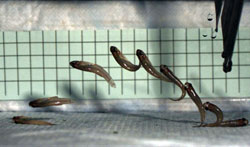Aquatic Fish Jump Into Picture of Evolutionary Land Invasion

Mosquitofish jumping behavior captured by a high-speed camera in the lab.<br>
This was no random flop, like you might see from a trout that’s just been landed. The rivulus seemed to know what it was doing.
They hadn’t expected to see that behavior, even from a fish known to spend time out of the water. So before long, what began as a study on the evolution of feeding behavior was shifted to a study of how fish behave when stranded on land. And considering what is implied by the truism “like a fish out of water,” the results came as another surprise.
Some fully aquatic fishes, as the author’s video clips show, also can jump effectively on land even without specialized anatomical attributes. This has significant implications for evolutionary biology, Gibb said, because the finding implies that “the invasion of the land by vertebrates may have occurred much more frequently than has been previously thought.”
The study is summarized in a paper, “Like a Fish out of Water: Terrestrial Jumping by Fully Aquatic Fishes,” that appears online in the JEZ A: Ecological Genetics and Physiology.
Gibb said the study “supports a big-picture theory in evolution,” which is that the nervous system, in its control of bones and muscles, can allow a new behavior to appear without necessarily bringing about a physical change.
In the case of aquatic fish, Gibb said, “This shows that you don’t have to have legs or rigid pectoral fins to move around on land. So if you go back and look at the fossil record to try to say which fish could move around on land, you’d have a hard time knowing for sure.”
The original feeding study began with guppies, then moved to a relative, the mangrove rivulus. Once the rivulus exhibited the tail-flip jumping maneuver, Gibb shifted the focus of the research. Eventually, the guppy came back into the picture. Literally.
“When you do a study like this, you have to ask what your control is,” Gibb said. “If a known amphibious fish is a good jumper, then what’s a bad jumper?”
Enter the guppy, a fully aquatic fish.
“The guppy jumped almost as well as the amphibious fish did,” Gibb said. “And no one has ever suggested that a guppy is an amphibious fish.” As a result, “we put everything we could get our hands on” in front of a high-speed camera, Gibb said. Some of those additional subjects included the mosquitofish, which has been introduced into tributaries of Oak Creek, and a common pet store zebra fish, which is a very distant relative of guppies and mosquitofish.
The mosquitofish “has become our lab rat,” Gibb said. “It’s accessible, it comes from a group that has other jumpers, and it’s been reported that this fish jumps out of the water to get away from predators and then jumps back in.”
That particular escape behavior, Gibb said, has never been filmed. Similar stories about other fish add to mostly anecdotal literature on the topic that “tends to be old and very diffuse.”
Today’s high-speed video systems give Gibb an opportunity to change that. What the cameras reveal is that both species produce a coordinated maneuver in which the fish curls its head toward the tail and then pushes off the ground to propel itself through the air.
Gibb and her team have discussed going into the field to capture video of fish performing this behavior in the wild. But for now Gibb and her colleagues are endeavoring to determine if there is directionality to voluntary locomotion on land and to investigate the genetic basis of the jumping behavior.
“Maybe fishes that are very good at jumping are poor swimmers,” Gibb said. “We want to look at the compromises that may have been made to favor one behavior over another.”
Media Contact
More Information:
http://www.nau.eduAll latest news from the category: Life Sciences and Chemistry
Articles and reports from the Life Sciences and chemistry area deal with applied and basic research into modern biology, chemistry and human medicine.
Valuable information can be found on a range of life sciences fields including bacteriology, biochemistry, bionics, bioinformatics, biophysics, biotechnology, genetics, geobotany, human biology, marine biology, microbiology, molecular biology, cellular biology, zoology, bioinorganic chemistry, microchemistry and environmental chemistry.
Newest articles

Security vulnerability in browser interface
… allows computer access via graphics card. Researchers at Graz University of Technology were successful with three different side-channel attacks on graphics cards via the WebGPU browser interface. The attacks…

A closer look at mechanochemistry
Ferdi Schüth and his team at the Max Planck Institut für Kohlenforschung in Mülheim/Germany have been studying the phenomena of mechanochemistry for several years. But what actually happens at the…

Severe Vulnerabilities Discovered in Software to Protect Internet Routing
A research team from the National Research Center for Applied Cybersecurity ATHENE led by Prof. Dr. Haya Schulmann has uncovered 18 vulnerabilities in crucial software components of Resource Public Key…





















